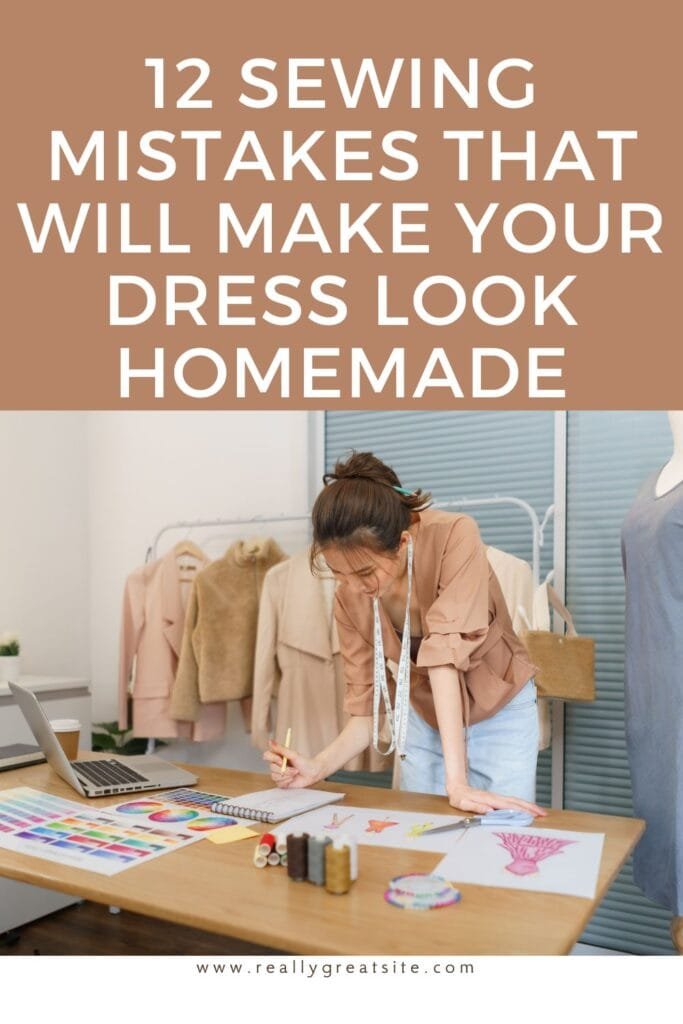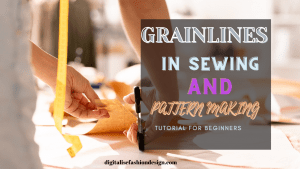This blog post will answer that question by showing you 12 sewing mistakes that will make your clothes look home-made.
What exactly makes clothes look homemade?
Avoiding these mistakes will show you how you can make your clothes look better.And how to turn out high-quality, professional-looking clothes
IMPROPER BODY MEASUREMENTS SEWING MISTAKE

If you’re a sewer and have been sewing for years, then this blog post might not be of much interest to you. However, if you’re just starting out and don’t know how to measure yourself accurately, then read on!
There are many ways to take properbody measurements and it’s important to get them right so that your clothes turn out the way they should.
This is the number one sewing mistake that will make your cloths look home made.
If your body is the wrong shape or size because of improper measuring techniques, then it can lead to making garments too small or large. The video below will show you how to properly measure yourself.
KNOWING AND UNDERSTANDING YOUR BODY SHAPE
When I started making my cloths,I had no idea about body shapes.
After several years of trial and error, I must say that making clothes for your body type is much easier.
Knowing your body shape will assist you when purchasing sewing patterns. Certain styles are better suited to certain body types. If you dont know how to know your body shape,that is not a problem.
Check out this blog post that will assist you in determining your body shape. This will then help you in getting the best pattern style for your shape.
A lot of people do not border about knowing their body shape.But believe me this is one of the sewing mistakes that make your cloths look home made.
This you can avoid by knowing styles that fit your body shape before going out to purchase any pattern style.
NOT USING FABRIC THAT MATCHES THE PATTERN
What is the most important thing to consider when choosing fabric for a project? For many, it’s what color or pattern they want.
However, there are other factors that you should take into consideration before making your decision.
Fabric weight and texture are two of these considerations.
The type of cloth pattern you’re looking for will also determine the type of fabric you need to purchase.
There are different types of fabrics available on the market today, each with specific qualities that make them perfect for certain projects.
Commercial patterns contain valuable information on the kind of fabric that suit a particular design.

It is always best to stick to the suggested fabric in the pattern instructions.That can help you avoid a lot of sewing mistakes.
Doing this will help you produce proffesional looking cloths.
Rather than cloths that look home made
SEWING MISTAKE OF USING THE WRONG THREAD
“What are the differences between all the different threads out there?
Which thread should I use for what type of sewing project?”
This blog post covers, in depth, which types of thread you can use for specific projects. It also explores the pros and cons of each type of thread so that you know which one is best suited to your needs.
Always choose a good quality thread in a fiber similar to fabric being used.
Using the right thread in the right fibre and colour is very important.
It can make all the difference between your cloth looking proffesional or home made.
checkout the video below by National sewing circle if you’re interested in learning more about choosing the right thread!
NOT USING THE RIGHT CUTTING TOOLS FOR YOUR FABRIC:SERIOUSE SEWING MISTAKE
Have you ever tried using blunt scissors to cut your fabric?
I have.
It never gives you a straight cut.
If you are a creative person who likes to sew, then there is no doubt that you have encountered some problems when cutting fabric.
There are many tools out there for this purpose but it can be hard to know which one is best for your needs.
This blog post will help you find the right tool for your needs by discussing the advantages of using the different types of scissors and rotary cutters .I also discuss how each type works and what their limitations are.
Perfect proffessional looking cloths start with perfect pattern cutting.To do this,you need the right cutting tools for your fabric.
Using a blunt cutting tool is one of the greatest sewing mistakes that will make your cloths look home made.
avoid it at all cost.
The sewing mistake of sewing without patterns
It is good to learn how to cut styles with basic body measurements.
Expecially if one is sewing traditional African attires.
For me however,nothing beats sewing with patterns.
Sewing is an art and takes practice. The good news is, there’s help at your fingertips with sewing patterns!
A pattern allows you to follow easy step-by-step instructions that will show even the most basic sewer how to create professional looking garments.
Patterns also include measurements for different sizes so they’ll fit anyone from petite women to plus size men. Plus, using pre-made patterns eliminates any guesswork involved in drafting one of your own – no more frustrating trial and error!
If working with patterns seem complicated for you,I have simplified it in this two blog post
Patterndrafting tools and their functions
Pattern drafting for the beginner
There are a lot of commercial patterns you can buy online to use
Including FREE pattern-making software. But the simpliest pattern-making system I have been using for over 12 years is the lutterloh pattern making system.
Feel free to check out these youtube videos on how to use this system to make proffessional fitting cloths.
THE SEWING MISTAKE OF USING THE WRONG PATTERN SIZE
When it comes to choosing the right pattern size ,people have a lot of questions like;
“I’m not sure I know how to choose the right size pattern for my sewing project.
How do I make this decision?”
“Well, it’s fairly simple once you get the hang of it. There are a few steps that will help narrow down your search.”
Before you can make your first stitch, it’s important to know the pattern size and the corresponding fabric type.
Ready to get started? Let’s do this!
I’m going to show you in this blog post how to choose the right pattern size for your sewing needs by giving some tips on what you neeed to look out for.Not using the right pattern size is a huge sewing mistake to avoid
NOT UNDERSTANDING OR FOLLOWING PATTERN INSTRUCTIONS
When a beginner sews for the first time, he or she may become overwhelmed by a sewing pattern.
With so many pattern symbols, learning to read sewing patterns may feel a little like learning a new language.
Creating time first to read and understand the pattern you want to use can solve a lot of sewing mistakes.
Most times we are in a hurry to just sew.We dont want to waste time to study any pattern!
I get it. I am also guilty of this.
Experience however has thought me that not following pattern instructions has cost me a lot of time.This blog post gives step by step details on how to understand pattern symbols and instructions.
NOT PROPERLY PLACING YOUR PATTERN BEFORE CUTTING FABRIC
Knowing how to cut your patterns is great.
However , learning the rules in pattern layout,is very important .
. It’s time to lay out pattern pieces now that your fabric is ready to be cut.
If you want to avoid the sewing mistake that will make your cloth look homemade,, make sure your pattern pieces are correctly placed on your fabric.
If the pattern pieces are not cut straight, they will not hang straight on your body. And there is no alteration that can correct a pattern that has been improperly cut.
This detailed blogpost by Katrinakaycreations tell you about areas of pattern layout and cutting that will lead to sewing success.
SEWING MISTAKE OF USING THE WRONG INTERFACING
Interfacing is the building blocks of sewing.
They give the dress structure and fit.
I’m going to share with you a little secret about how I save time and frustration on my sewing projects.
My secret is interfacing!
If you have ever used the wrong kind of interfacing for your project, then this post is for you.
This blog post shows some common mistakes that people make when using interfacing and give some tips on what type of interfacing should be used in each situation.
If all else fails, there are plenty of tutorials out there on YouTube or Pinterest showing different types of interfaces and how they differ from one another. Take a look at the vidoe below if you need more help deciding which type of interface to use!
SEWING MISTAKE OF NOT IRONING, AS YOU SEW
Ironing has always been the bane of sewing. No matter how short your project, there is never enough time to iron it before you sew up all those pesky seams.
The quality of your finished garment is greatly influenced by how well you press it. If you skip this step, all of your hard work and time spent at the sewing machine will be for naught.
A small ironing board or ironing pad near your sewing station will make pressing nice and easy.
I have a cute portable ironing board close to me when I sew.
You’ll be glad you put in the extra effort when you see the end result.
It also saves time and effort. If you are noticing that your seams aren’t lining up, it may be because of the ironing! Ironing before sewing will help keep everything lined up and make your project look better in the end.And at the same time, avoid a lot of sewing mistakes.
USING THE WRONG SEAM FINISH FOR YOUR FABRIC
The hem is usually the last step in the process of finishing a garment.
If you choose the incorrect hem finish for your garment, it will stand out like a sore thumb. For some reason, the eye is drawn to it immediately. All of your hard work on the rest of the garment will be overshadowed by it.
Do you know how to choose the right seam finish for your fabric?
I’m sure you’ve heard of serging, but did you know there are different types of edge finishing in sewing?And different types of seam finishing techniques.
There’s a lot more to this than most people realize. and
This blog post by Treasury walks you through some of the most popular types like overlock, rolled edge, zigzag stitch and bound seams .
It will help you to choose which one will work best for your needs.
So let’s get started!
CONCLUSION
Thats my take on 12 sewing mistakes that will make your cloths look home made.
Do you know of any other sewing mistakes to avoid?Please drop your comments below.





